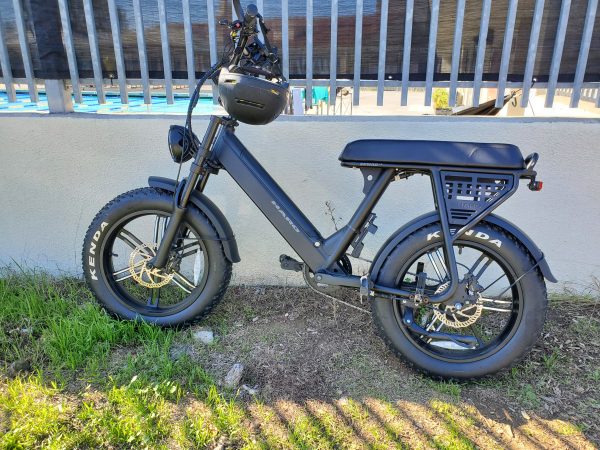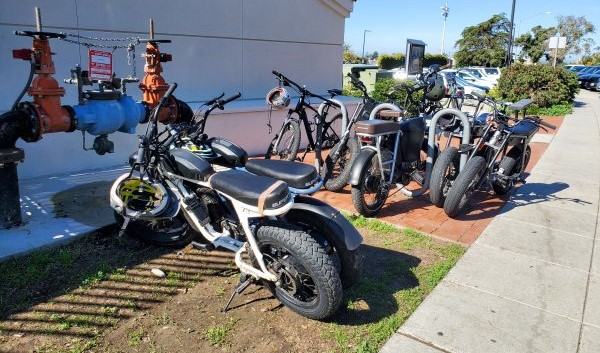This is the first part of a series exploring electric bicycles, their local impact and the ongoing controversy that surrounds them.
Electric bicycles, or e-bikes, have become an omnipresent part of life in La Jolla and many other parts of Southern California — divisive as they may be.
Loved by riders and loathed by many who share the streets with them, their relatively recent ubiquitousness has led to a scramble in enforcement and education designed to increase safety and reduce misuse.
So how did we get here? Part 1 of the La Jolla Light’s series “Charged Up: The Rise of E-bikes” looks at the nuts and bolts of e-bikes, their different classes, how they arrived, their appeal to riders and the rules that apply to them.
What is an e-bike?
According to the San Diego Police Department, an e-bike is a “bicycle equipped with fully operable pedals and an electric motor of less than 750 watts.”
The first modern pedal-controlled e-bikes came in the 1990s and developed further with affordable, high-energy lithium-ion batteries and lighter motors, providing faster charging times and longer range. In recent years they’ve exploded in popularity.
The bikes, which are rechargeable, come in three street-legal classes:
• Class 1 is equipped with a motor that provides assistance when the rider is pedaling and can reach speeds up to 20 mph.
• Class 2 is equipped with a motor that may be used exclusively to propel the bicycle (with a throttle) and can reach speeds up to 20 mph.
• Class 3 is equipped with a motor that provides assistance when the rider is pedaling and can reach speeds up to 28 mph.
E-bikes are different from another type of bike — an e-dirt bike, also called an electric motorcycle or e-moto. Those bikes are legal in California only for off-road use and are distinct from e-bikes in that there are no pedals on e-motorcycles.
 An e-bike is parked near La Jolla High School. (Ashley Mackin-Solomon)
An e-bike is parked near La Jolla High School. (Ashley Mackin-Solomon)
Why are e-bikes popular?
Pedego Electric Bikes La Jolla opened in 2017 at 5702 La Jolla Blvd., and according to Terry Galka, co-owner alongside Tracy Sheffer, the business keeps growing. Its website states there are more than 200 stores dedicated to the Pedego brand around the world.
The appeal of e-bikes is twofold, Galka said.
“I think for the kids, it gives them freedom and responsibility,” he said. “And for adults, it gives them the opportunity to kind of bring back their childhood and ride a bike again.”
While some businesses see sales increases during holidays or other parts of the year, business is fairly consistent year-round for his and other stores in California, Galka said.
“Sometimes the holidays do spike the sales,” he said. “But I think … our [business] is based on weather. We always have good weather, and when it’s really nice out, it seems like a lot of people get out there and really want to get bikes.”
Pedego La Jolla currently offers 18 types, including the original “cruiser” and the “commuter” and “adventure” options. Prices on the store’s website range from about $1,000 to just under $4,000.
La Jolla Ebike & Skate, a retailer at 7444 Girard Ave., is only 2 years old but the address has hosted multiple e-bike companies in just under a decade.
Ray Belden previously ran San Diego Electric Bike’s La Jolla satellite location as general manager and head tech. But when the primary store in Solana Beach was sold and the La Jolla location closed, he took over the lease and launched La Jolla Ebike & Skate. Earlier, San Diego Fly Rides occupied the space, Belden said.
La Jolla Ebike & Skate offers a selection of California-based brands, such as E Ride Pro (off-road e-motos), P-51 and Monday Motorbikes.
E-bikes are appealing for their lack of emissions, ease of use and parking and relative affordability, Belden said.
“If you are in an area like La Jolla or Southern California where weather is relatively nice year-round, you can rely on it as transportation rather than having to take public transportation or drive a car,” he said. “More and more people are interested in getting around on an easy way to ride, and sales are constantly increasing. It’s a viable option for a lot of people for transportation.”
Rules and regulations
As with any vehicle, there are rules that riders must follow. The San Diego Police Department classifies e-bikes as bicycles and therefore riders must abide by all applicable laws.
Class 1 and 2 e-bikes are permitted on bike paths, including the La Jolla Bike Path, as well as multi-use paths and roadway bike lanes. Class 3 e-bikes are allowed on bike lanes but generally are prohibited on bike paths, including La Jolla’s, and multi-use paths.
Electric bikes are prohibited at the La Jolla Shores boardwalk and on sidewalks, hiking trails or natural areas unless specifically allowed.
A helmet is required for any rider younger than 18 on any class of e-bike and for any age on a Class 3 e-bike. Riders of Class 3 e-bikes must be at least 16.
E-bike riders are required to be on the right side of the road in the same direction as traffic and stay in a bike lane if one is available.
Drivers and passengers of any class of e-bike must have separate seating, and e-bikes cannot be left on sidewalks in a way that obstructs pedestrians.
A driver’s license, license plate, insurance and registration are not required for e-bikes.
Though kids often are drawn to electric dirt bikes, no one — including adults — is allowed to ride them on a street, bike path or sidewalk, San Diego police Officer Nick Tamagni told The San Diego Union-Tribune recently.
“Simply having one even on a sidewalk — the sidewalk counts as a roadway — or on the roadway itself can be an immediate stop-and-tow and citation,” Tamagni said.
Next installment
Given that e-bikes arrived on the scene without specific laws to regulate them, the next article in this series will focus on safety, past incidents and more. ♦

